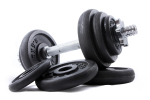|
2005/03/15, 08:39 AM
This may sound like a dumb question, but I was at the gym this morning and this guy told me that pasta and bread are bad because they eventually break down into sugar. I never heard that before i was wondering if i could get some info about this.
|
|
|
|
2005/03/15, 10:16 AM
Um he's 50% right. The right part is " they break down".
the wrong part is they do not break down into sugar. They break down in the body and turn into fat!
Simple carbs (as they are know)get stored as fat if not used for energy. This includes any white foods such as "white bread, sugar,rice, and others etc.
So be careful with pasta and bread.
--------------
Scales are for dead weight: We are not dead yet!
Still trying to find out how to do the Hollywood Free Press.
Ivan
carivan@freetrainers.com
Montreal Canada
|
|
2005/03/15, 04:18 PM
Thanks for the clarification!:big_smile:
|
|
2005/03/15, 11:25 PM
hmmm refined carbohyrdates like white pastas, they break down and turn to glucose, spiking your insulin levels making you retain fat don't they?
|
|
2005/03/15, 11:27 PM
OT - why do pictures take so long to change? these ones are months old and i cant upload any new ones.....
|
|
2005/03/16, 01:34 AM
but brown whole meal bread whats that stored as over time?
|
|
2005/03/16, 05:15 AM
All carbohydrates eventually break down into glucose (blood sugar) it’s the speed at which they breakdown that is important. The rate at which carbs break down is given by its position on the glycemic index (GI) scale. Glucose which is what carbohydrates finally end up as, has a GI rating of 100 so the closer a carbohydrates GI rating is to 100 is a good indicator of how quick the glucose within will be released to the blood. The higher up on the scale a food comes will correspond to a larger effect it will have on blood sugar and insulin levels some times you want this to be high, for instance after exercise and sometimes you want it to be lo. A lo GI food will give you a slower release of blood sugar over a sustained period so knowing the GI of certain foods would be beneficial in planning when to eat certain foods to fit your particular protocol.
Pasta ranges from 35 to 60 on the GI scale depending on the type. Once you have a grasp of the GI it is important also to look at the GL (glycemic load) this takes into account the actual amount of available energy from starch and sugar not fiber.
Here’s a link for a basic list of GI rating of some foods.
There may be better ones I just dug it up from Google for speed.
http://www.lowglycemicdiet.com/gifoodlist.html
|








